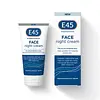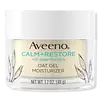What's inside
What's inside
 Key Ingredients
Key Ingredients

 Benefits
Benefits

 Concerns
Concerns

 Ingredients Side-by-side
Ingredients Side-by-side

Water
Skin ConditioningMacadamia Integrifolia Seed Oil
Skin ConditioningPrunus Amygdalus Dulcis Oil
Skin ConditioningPentylene Glycol
Skin ConditioningGlycerin
HumectantSimmondsia Chinensis Seed Oil
EmollientStearyl Alcohol
EmollientPolyglyceryl-2 Stearate
EmulsifyingBehenyl Alcohol
EmollientTheobroma Cacao Seed Butter
EmollientButyrospermum Parkii Butter
Skin ConditioningGlyceryl Stearate
EmollientHydrogenated Rapeseed Alcohol
EmollientPolyglyceryl-10 Eicosanedioate/Tetradecanedioate
Skin ConditioningBetaine
HumectantXanthan Gum
EmulsifyingTocopheryl Acetate
AntioxidantLevulinic Acid
PerfumingSodium Anisate
AntimicrobialSodium Levulinate
Skin ConditioningPolyglyceryl-4 Oleate
EmulsifyingTocopherol
AntioxidantSodium Hydroxide
BufferingHelianthus Annuus Seed Oil
EmollientGlyceryl Olivate
EmollientWater, Macadamia Integrifolia Seed Oil, Prunus Amygdalus Dulcis Oil, Pentylene Glycol, Glycerin, Simmondsia Chinensis Seed Oil, Stearyl Alcohol, Polyglyceryl-2 Stearate, Behenyl Alcohol, Theobroma Cacao Seed Butter, Butyrospermum Parkii Butter, Glyceryl Stearate, Hydrogenated Rapeseed Alcohol, Polyglyceryl-10 Eicosanedioate/Tetradecanedioate, Betaine, Xanthan Gum, Tocopheryl Acetate, Levulinic Acid, Sodium Anisate, Sodium Levulinate, Polyglyceryl-4 Oleate, Tocopherol, Sodium Hydroxide, Helianthus Annuus Seed Oil, Glyceryl Olivate
Water
Skin ConditioningGlycerin
HumectantDimethicone
EmollientCetearyl Olivate
Avena Sativa Kernel Flour
AbrasiveSorbitan Olivate
EmulsifyingPolyacrylamide
Synthetic Beeswax
Emulsion StabilisingPhenoxyethanol
PreservativeC13-14 Isoparaffin
EmollientButylene Glycol
HumectantDimethicone Crosspolymer
Emulsion StabilisingPanthenol
Skin ConditioningChlorphenesin
AntimicrobialDimethiconol
EmollientCarbomer
Emulsion StabilisingLaureth-7
EmulsifyingChrysanthemum Parthenium Flower/Leaf/Stem Juice
AntioxidantEthylhexylglycerin
Skin ConditioningSodium Hydroxide
BufferingAvena Sativa Kernel Extract
AbrasiveCentella Asiatica Extract
CleansingWater, Glycerin, Dimethicone, Cetearyl Olivate, Avena Sativa Kernel Flour, Sorbitan Olivate, Polyacrylamide, Synthetic Beeswax, Phenoxyethanol, C13-14 Isoparaffin, Butylene Glycol, Dimethicone Crosspolymer, Panthenol, Chlorphenesin, Dimethiconol, Carbomer, Laureth-7, Chrysanthemum Parthenium Flower/Leaf/Stem Juice, Ethylhexylglycerin, Sodium Hydroxide, Avena Sativa Kernel Extract, Centella Asiatica Extract
 Reviews
Reviews

Ingredients Explained
These ingredients are found in both products.
Ingredients higher up in an ingredient list are typically present in a larger amount.
Glycerin is already naturally found in your skin. It helps moisturize and protect your skin.
A study from 2016 found glycerin to be more effective as a humectant than AHAs and hyaluronic acid.
As a humectant, it helps the skin stay hydrated by pulling moisture to your skin. The low molecular weight of glycerin allows it to pull moisture into the deeper layers of your skin.
Hydrated skin improves your skin barrier; Your skin barrier helps protect against irritants and bacteria.
Glycerin has also been found to have antimicrobial and antiviral properties. Due to these properties, glycerin is often used in wound and burn treatments.
In cosmetics, glycerin is usually derived from plants such as soybean or palm. However, it can also be sourced from animals, such as tallow or animal fat.
This ingredient is organic, colorless, odorless, and non-toxic.
Glycerin is the name for this ingredient in American English. British English uses Glycerol/Glycerine.
Learn more about GlycerinSodium Hydroxide is also known as lye or caustic soda. It is used to adjust the pH of products; many ingredients require a specific pH to be effective.
In small amounts, sodium hydroxide is considered safe to use. However, large amounts may cause chemical burns due to its high alkaline.
Your skin has a natural pH and acid mantle. This acid mantle helps prevent harmful bacteria from breaking through. The acid mantle also helps keep your skin hydrated.
"Alkaline" refers to a high pH level. A low pH level would be considered acidic.
Learn more about Sodium HydroxideWater. It's the most common cosmetic ingredient of all. You'll usually see it at the top of ingredient lists, meaning that it makes up the largest part of the product.
So why is it so popular? Water most often acts as a solvent - this means that it helps dissolve other ingredients into the formulation.
You'll also recognize water as that liquid we all need to stay alive. If you see this, drink a glass of water. Stay hydrated!
Learn more about Water